Project details
Status: Current
Building back-up for bees
Researchers from the Tasmanian Institute of Agriculture (TIA) are making a ‘beeline’ for cherry orchards and onion seed crops in the pursuit of pollen.
Their aim is to develop a mechanised pollination system as a form of ‘bee insurance’ and to improve crop performance for growers.
Mechanical pollination involves humans intervening and physically collecting pollen from flowers and reapplying it when and where it is needed.

Future proofing pollination
The team is looking at both future proofing pollination services and creating better outcomes for our fruit and vegetable industries.
Growers currently rely strongly on one species of insect, the honeybee, to pollinate flowering horticultural crops. This leaves us incredibly vulnerable to honeybee threats such as varroa mite and even bushfires.
Mechanical pollination is just one element of a safety net being developed to ensure our horticultural crops are pollinated in a worst-case scenario.
The broader national research program, funded by Rural R&D for Profit, is investigating alternative pollinators such as flies and stingless bees, revegetation of native insect habitat and bee health under protected cultivation systems.
Bee pollination supplementation
Mechanical pollination’s future use is really designed to supplement bee pollination.
Bee assisted pollination is not always perfect. Moving many of our horticultural crops under nets and plastic covers has put added pressure on our bees, particularly their navigation systems, upsetting both pollination and bee health.
Mechanical Pollination
The current research on mechanical pollination, whilst still at the ‘proof of concept’ stage, is one component of a pollination insurance policy for our horticultural industries with the added potential for new more sophisticated and targeted pollination services in the future.
Related stories
For more information contact:
Acknowledgements:
Delivered by Hort Innovation, from the Australian Government Department of Agriculture, Water and the Environment as part of its Rural R&D for Profit program